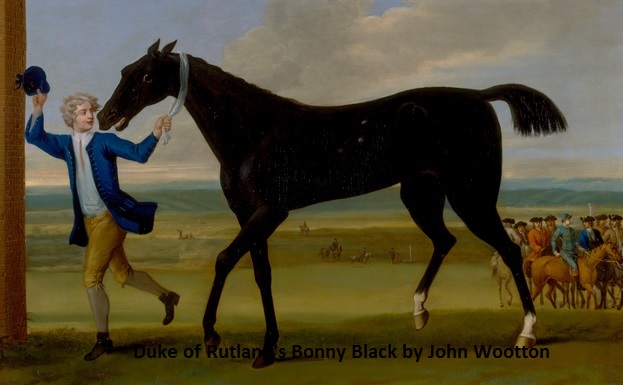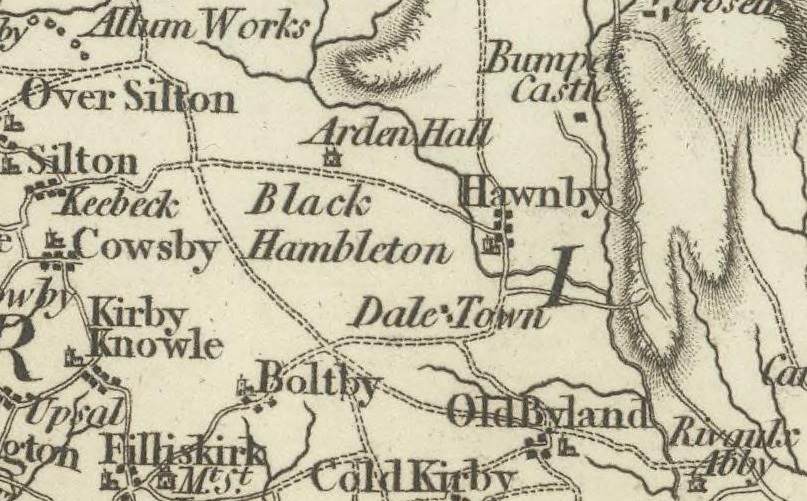Earliest meeting: July 1612
Final meeting: Saturday 27th July 1811
If the racegoers of today were asked to name the three longest-established racecourses in Britain they might well choose Newmarket, York and Chester, although Ascot, Doncaster or even Goodwood would be included by some people, but few would mention Hambleton. Hambleton is situated near Thirsk, close to the village of Cold Kirby, in sight of the Black Hambleton hills. Racing at Hambleton was recorded as early as July 1612, which suggests that it was in place even before Newmarket. A key success indicator for any meeting in those early days was to get royal approval. Newmarket got its through James I and Hambleton was supported by Queen Anne until her death in 1714. The Queen Anne Cup was for horses, mares or geldings up to 5 years old to race over a 4 mile circuit and carry 10 stone. After her death a plate was given to the winner, with the first recipient being Mr Gage’s Who-would-have-thought-it. Often, in the early days, the meeting was referred to as 'Black Hambleton' although that area was far too hilly and the meeting itself was staged a short distance south. Such was the attendance at the meetings that in the 1740s there was a bid to reduce the number of meetings because of 'rougher elements' enjoying the races too much and losing valuable days work. The method of reduction was to prohibit meetings where the prize money was less than £50 per race. However, three exceptions were given to ensure that racing continued to take place in the important areas; Newmarket and York were two of the exceptions, whilst the third was Black Hambleton. Baily’s Racing Register first provided detailed results from races held at Black Hambleton in August 1715 when His Majesty’s Gold Cup went to Who-would-have-thought-it. By 1719 Baily’s Racing Register was referring to the meeting merely as Hambleton, as opposed to Black Hambleton, when the Duke of Rutland’s Bonny Black won the Gold Cup. On Saturday 8th August 1779 new ground was broken at Hambleton when the first race for 2 year olds in the north was held. Up to then horses had to be aged 3 before they could race, and not long before this date horses had to reach the age of 4 before commencing racing. It is not surprising that the meeting at Hambleton finally died out; indeed the surprise is that it lasted so long, given its location and the difficulties of getting to the meeting for horses, owners and punters. The final meeting took place on Saturday 27th July 1811 and all evidence of the existence of such an important race meeting has now vanished forever.
Saturday 8th August 1719
His Majesty’s Gold Cup value 100 Guineas over 4 miles
1. Bonny Black owned by The Duke of Rutland
2. Unnamed mare owned by Mr Watson
3. Unnamed mare owned by Sir R Milbank
There were a further 28 runners in what was a very competitive race.
The Queen Anne's Gold Cup competed for annually at Hambleton Racecourse.

It seems remarkable that Bonny Black should win a race for 5 year olds in consecutive years. The most likely explanation is that she was 4 when she won it in 1719 and she was still allowed to enter in 1720 and duly won it. The plot thickens further when the records for Hambleton are examined more deeply and it is realised that Bonny Black triumphed in 1711, but the most likely explanation here is that her mother was also named Bonny Black.
The King’s Plates, valued at 100 guineas, were a series of annual races which date from the time of Charles II and continued in some form or other up to 1887. From the publication of the first Racing Calendar in 1727 by John Cheny, up to 1751, the Plates were restricted to 6 year olds each carrying 12 stone and were run over three 4 mile heats. In 1751 they were staged at Guildford, Hambleton, Ipswich, Lewes, Lincoln, 3 at Newmarket, Nottingham, Winchester and York. After 1751 younger horses were permitted to run in King’s Plates, with 5 year olds allocated 10 stone and four year olds 9 stone.
Prior to 1727 it was universally accepted that horses should be at least 5 years old before racing; indeed horses had to be 6 before contesting the prestigious King’s Plates. However, in August 1727 Black Hambleton staged a 20 Guineas Plate for 4 year olds, each carrying 9 stone. A field of 14 faced the starter and the race was won by Miss Pert, owned by Mr Hudson, although at the time of the race the horse was described as an ‘unnamed bay mare by Thoulouse Barb’.

It is not surprising that the meeting at Hambleton finally died out; indeed the surprise is that it lasted so long given the difficulties of getting to the meeting for horses, owners and punters. The final meeting took place on 27th July 1811 and all evidence of the existence of such an important race meeting has now vanished forever.
Much of the information about this course has been found using internet research and is in the public domain. However, useful research sources have been:-
London Illustrated News
Racing Illustrated 1895-1899
The Sporting & Dramatic Illustrated
Northern Turf History Volumes 1-4 by J.Fairfax-Blakeborough
The Sporting Magazine
A Long Time Gone by Chris Pitt first published in 1996 ISBN 0 900599 89 8
Racing Calendars which were first published in 1727



